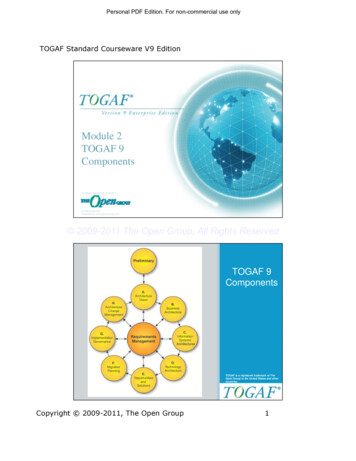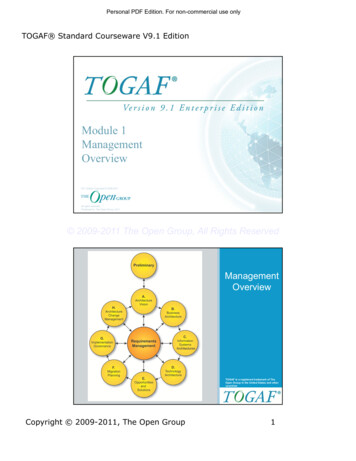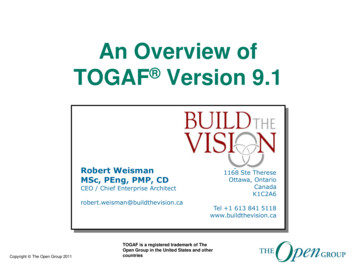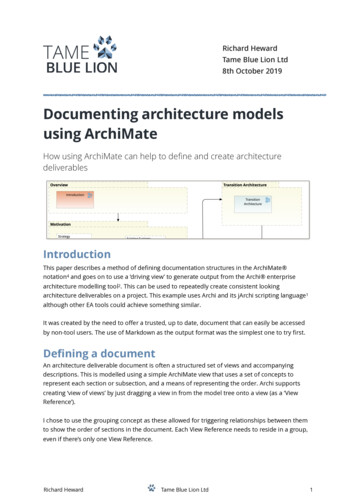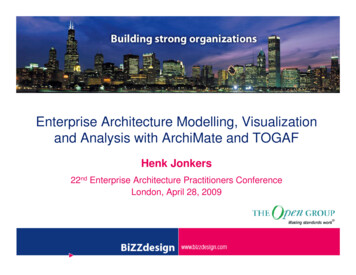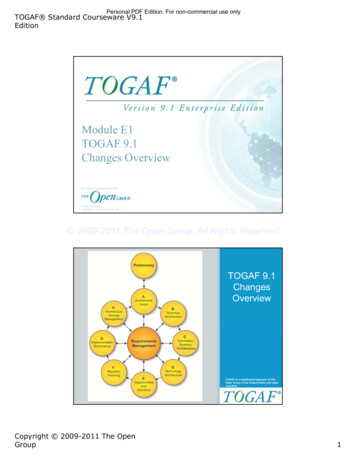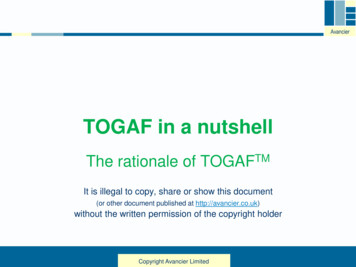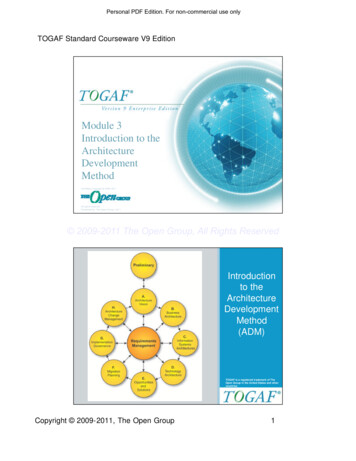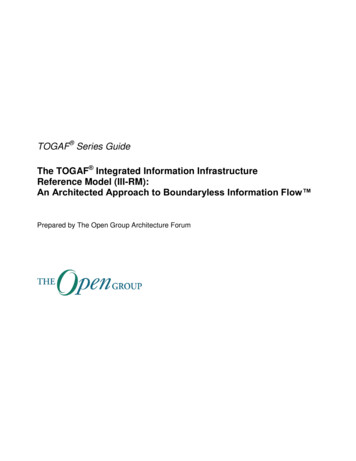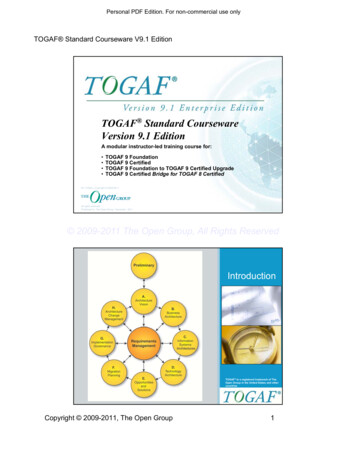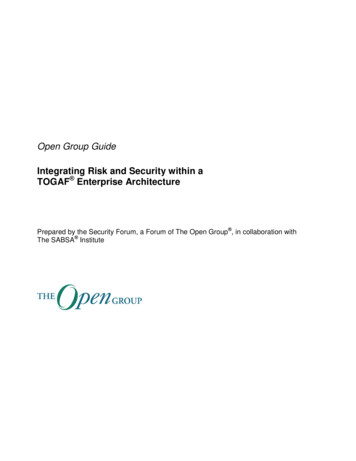
Transcription
TOGAF 9 and ArchiMate 1.0A White Paper by:Henk Jonkers, Erik Proper, and Mike TurnerNovember 2009
TOGAF 9 and ArchiMate 1.0Copyright 2009 The Open GroupAll rights reserved. No part of this publication may be reproduced, stored in aretrieval system, or transmitted, in any form or by any means, electronic,mechanical, photocopying, recording, or otherwise, without the priorpermission of the copyright owners.This White Paper is an informational document and does not form part of theTOGAF documentation set. Readers should note that this document has notbeen approved through the formal Open Group Standards Process and doesnot represent the formal consensus of The Open Group Architecture Forum.Object Management Group and Unified Modeling Language aretrademarks and UML is a registered trademark of the Object ManagementGroup.Boundaryless Information Flow and TOGAF are trademarks andArchiMate , Making Standards Work , The Open Group , UNIX , and the“X” device are registered trademarks of The Open Group in the United Statesand other countries. All other trademarks are the property of their respectiveowners.TOGAF 9 and ArchiMate 1.0Document No.:W191Published by The Open Group, November 2009Any comments relating to the material contained in this document may besubmitted to:The Open Group44 Montgomery St. #960San Francisco, CA 94104or by email to:ogpubs@opengroup.orgwww.opengroup.orgAWhite Paper Published by The Open Group2
TOGAF 9 and ArchiMate 1.0Table of ContentsIntroduction5Ingredients of an Enterprise Architecture Approach .5Overview of the TOGAF Specification6Overview of the ArchiMate Specification8Common Foundation9Views, Viewpoints, and Stakeholders .10TOGAF and ArchiMate11ArchiMate and the Architecture Content Framework .11ArchiMate, the Enterprise Continuum, and TOGAF Reference Models.12ArchiMate Models Throughout the ADM.13Summary .20www.opengroup.orgConclusions21References22About the Authors23About The Open Group23AWhite Paper Published by The Open Group3
TOGAF 9 and ArchiMate 1.0Boundaryless Information Flow achieved through global interoperabilityin a secure, reliable, and timely mannerExecutive SummaryThis White Paper discusses the TOGAF 9 and ArchiMate 1.0 specifications,illustrating how these two open standards of The Open Group can be used together.The main observations are: TOGAF and ArchiMate overlap in their use of viewpoints, and the concept ofan underlying common repository of architectural artifacts and models; i.e.,they have a firm common foundation. TOGAF and ArchiMate complement each other with respect to the definitionof an architecture development process and the definition of an enterprisearchitecture modeling language. ArchiMate 1.0 chiefly supports modeling of the architectures in Phases B, C,and D of the TOGAF Architecture Development Method (ADM). Theresulting models are used as input for the subsequent ADM phases. However,modeling concepts specifically aimed at the other phases – e.g., concepts formodeling principles, goals and requirements, or concepts to support migrationplanning – are still missing in the language. This observation points in adirection for possible language extensions in future versions of ArchiMate.This paper supports Boundaryless Information Flow by discussing how two OpenGroup specifications can be used in combination.www.opengroup.orgAWhite Paper Published by The Open Group4
TOGAF 9 and ArchiMate 1.0IntroductionWhenever enterprise architecture is considered to be the “weakest link” in an organization, preventing it fromachieving whatever business strategy it may have, the advocates of new architecture support tools claim thatthey have the silver bullet that will easily cure all major prevailing problems. It is subsequently assumed thathaving such a tool will give business professionals not only more control over the IT complexity, but willalso help them develop organization-wide information systems that follow, serve, and implement thecorporate business strategy and seamlessly integrate with business processes. Thus, enterprise architecturetools appear to hold the potential of allowing organizations to derive maximum business value from ITinvestments and to become flexible and coherent in the management of organizational changes, resources,and planning.In this White Paper we argue that, besides tools, organizations need a complete approach to guide thedevelopment of enterprise architecture, from strategy and requirements to implementation and maintenance.Our goal in this paper is to demonstrate that such an approach can result from the combination of two openstandards for enterprise architecture currently promoted by The Open Group. The first one, The Open GroupArchitecture Framework (TOGAF 9) [7], has been for more than a decade the world’s leading (enterprise)architecture method. The second one, ArchiMate 1.0, has recently been adopted as an Open Group standardfor modeling enterprise architectures [3, 8].One of the strengths of the TOGAF method is its ability to stress the importance of stakeholder concerns foreach enterprise architecture development phase: creation, change, and governance. This ability may suggestthat TOGAF also describes how an architect should address these concerns. This, however, is not the case.What TOGAF actually offers is a sort of “open interface” for the declaration of such a “concern”. The actualspecification of the concern is left to any suitable modeling language which is capable of capturing suchconcerns and is compliant with the ISO/IEC 42010:2007 standard [1].ArchiMate is such a modeling standard: it follows the definitions and relationships of the concepts ofconcern, viewpoint, and view proposed by the ISO/IEC 42010:2007 standard for architecture description. TheArchiMate framework is therefore capable of defining stakeholder concerns in viewpoints, while theArchiMate language is capable of addressing these with corresponding views showing the right aspects of thearchitecture conforming to defined viewpoints.Ingredients of an Enterprise Architecture ApproachEnterprise architecture frameworks vary in the aspects they cover. They may have, among others, anycombination of the following ingredients (see Figure 1): A process (“way of working”) for creating architectures; this may be accompanied by guidelines,techniques, and best practices A set or classification of viewpoints A language for describing architectures (defining concepts and relationships, but also a notation) The concept of a (virtual) architecture repository, possibly containing predefined architectural artifactsand (reference) modelswww.opengroup.orgAWhite Paper Published by The Open Group5
TOGAF 9 and ArchiMate 1.0ProcessViewpointsLanguageRepository, (Reference) ModelsFigure 1: Ingredients of an Enterprise Architecture ApproachThe core of TOGAF is a process – the Architecture Development Method (ADM); it also describesviewpoints, techniques, and reference models, but not a complete language (the Architecture ContentFramework identifies relevant architecture building blocks, but it does not constitute a formal modelinglanguage, nor a notation).ArchiMate describes viewpoints and provides a formal modeling language, including a (graphical) notation.TOGAF and ArchiMate overlap in their use of viewpoints, and the concept of an underlying commonrepository of architectural artifacts and models; i.e., they have a firm common foundation.TOGAF and ArchiMate complement each other with respect to the definition of an architecture developmentprocess and the definition of an enterprise architecture modeling language.In this White Paper, we show an impression of how the current versions of TOGAF and ArchiMate mightwork together. Although there are still some gaps, there are no objections to starting with the combined use ofTOGAF 9 and ArchiMate 1.0 now. Further versions of the standards may lead to an even better integration,whilst ensuring that current investments in terms of models describing baseline and/or target architectures areretained. For a vision on the future co-existence of TOGAF and ArchiMate, we refer to a separate WhitePaper on this topic [9].Overview of the TOGAF SpecificationThe Open Group Architecture Framework (TOGAF) is a framework – a detailed method and a set ofsupporting tools – for developing an enterprise architecture. It may be used freely by any organizationwishing to develop an enterprise architecture for use within that organization.There are seven main parts to the TOGAF document: PART I: IntroductionThis part provides a high-level introduction to the key concepts of enterprise architecture and inparticular the TOGAF approach. It contains the definitions of terms used throughout TOGAF andrelease notes detailing the changes between this version and the previous version of TOGAF. PART II: Architecture Development MethodThis part is the core of TOGAF. It describes the TOGAF ADM – a step-by-step approach to developingan enterprise architecture (see Figure 2). PART III: ADM Guidelines and TechniquesThis part contains a collection of guidelines and techniques available for use in applying TOGAF andthe TOGAF ADM.www.opengroup.orgAWhite Paper Published by The Open Group6
TOGAF 9 and ArchiMate 1.0Figure 2: The TOGAF Architecture Development Method (ADM) PART IV: Architecture Content FrameworkThis part describes the TOGAF content framework, including a structured metamodel for architecturalartifacts (see Figure 3), the use of re-usable architecture building blocks, and an overview of typicalarchitecture deliverables.Figure 3: The TOGAF Architecture Content Framework PART V: Enterprise Continuum & ToolsThis part discusses appropriate taxonomies and tools to categorize and store the outputs of architectureactivity within an enterprise.www.opengroup.orgAWhite Paper Published by The Open Group7
TOGAF 9 and ArchiMate 1.0 PART VI: TOGAF Reference ModelsThis part provides a selection of architectural reference models, which includes the TOGAF FoundationArchitecture, and the Integrated Information Infrastructure Reference Model (III-RM). PART VII: Architecture Capability FrameworkThis part discusses the organization, processes, skills, roles, and responsibilities required to establishand operate an architecture function within an enterprise.Overview of the ArchiMate SpecificationThe ArchiMate enterprise architecture modeling language has been developed to provide a uniformrepresentation for architecture descriptions. It offers an integrated architectural approach that describes andvisualizes the different architecture domains and their underlying relationships and dependencies.In a short time, ArchiMate has become the open standard for architecture modeling in the Netherlands; it isnow also becoming well known in the international enterprise architecture community, and recently it hasbeen brought under the aegis of The Open Group.The ArchiMate standard is structured as follows: Chapter 1: Introduction Chapter 2: Enterprise ArchitectureThis chapter makes the case for enterprise architecture and for the necessity of a modeling standard forenterprise architecture. Chapter 3: Language StructureThis chapter presents some general ideas, principles, and assumptions underlying the development ofthe ArchiMate metamodel (illustrated in Figure 4) and introduces the ArchiMate framework (see Figure5).Figure 4: Structure of the ArchiMate Languagewww.opengroup.orgAWhite Paper Published by The Open Group8
TOGAF 9 and ArchiMate 1.0Figure 5: The ArchiMate Framework Chapter 4: Business LayerThis chapter covers the definition and usage of the business layer modeling concepts, together withexamples. Chapter 5: Application LayerThis chapter covers the definition and usage of the application layer modeling concept, together withexamples. Chapter 6: Technology LayerThis chapter covers the definition and usage of the technical infrastructure layer modeling concept,together with examples. Chapter 7: Cross-Layer Dependencies and Chapter 8: RelationshipsThese chapters cover the definition of relationship concepts in a similar way. Chapter 9: Architecture ViewpointsThis chapter presents and clarifies a set of architecture viewpoints, developed in ArchiMate based onpractical experience. All ArchiMate viewpoints are described in detail. For each viewpoint, thecomprised concepts and relationships, the guidelines for the viewpoint use, and the goal and targetgroup of the viewpoint are specified. Furthermore, each viewpoint description contains example models. Chapter 10: Language Extension MechanismsThis chapter handles extending and/or specializing the ArchiMate core language for specialized ordomain-specific purposes. Chapter 11: Future DirectionsThis chapter identifies extensions and directions for developments in the next versions of the language.Common FoundationEstablishing and maintaining a coherent enterprise architecture is clearly a complex task, because it involvesmany different people with differing backgrounds using various notations. In order to get a handle on thiscomplexity, researchers have initially focused on the definition of architectural frameworks for classifyingand positioning the various architectural descriptions with respect to each other (e.g., the Zachmanframework [6, 10]). A problem with looking at enterprise architecture through the lens of an architecturalwww.opengroup.orgAWhite Paper Published by The Open Group9
TOGAF 9 and ArchiMate 1.0framework is that it categorizes and divides architectural descriptions rather than providing insight into theircoherence.Views, Viewpoints, and StakeholdersViews are an ideal mechanism to purposefully convey information about architecture areas. In general, aview is defined as a part of an architecture description that addresses a set of related concerns and isaddressed to a set of stakeholders. A view is specified by means of a viewpoint, which prescribes theconcepts, models, analysis techniques, and visualizations that are provided by the view. Simply put, a view iswhat you see, and a viewpoint is where you are looking from.Figure 6: Metamodel from ISO/IEC 42010:2007 [1]Viewpoints are a means to focus on particular aspects of the architecture. These aspects are determined by theconcerns of a stakeholder with whom communication takes place. What should and should not be visiblefrom a specific viewpoint is therefore entirely dependent on the argumentation with respect to a stakeholder’sconcerns.Viewpoints are designed for the purpose of communicating certain aspects of an architecture. Thecommunication enabled by a viewpoint can be strictly informative, but in general will be bi-directional. Thearchitect informs stakeholders, and stakeholders give their feedback (critique or consent) on the presentedaspects. What is and what is not shown in a view depends on the scope of the viewpoint and on what isrelevant to the concerns of the stakeholder. Ideally, these are the same; i.e., the viewpoint is designed withspecific concerns of a stakeholder in mind. Relevance to a stakeholder’s concern, therefore, is the selectioncriterion that is used to determine which objects and relations are to appear in a view.The following are examples of stakeholders and concerns as a basis for the specification of viewpoints: End user: For example, what are the consequences for his work and workplace?www.opengroup.orgAWhite Paper Published by The Open Group10
TOGAF 9 and ArchiMate 1.0 Architect: What is the consequence for the maintainability of a system, with respect to corrective,preventive, and adaptive maintenance? Upper-level management: How can we ensure our policies are followed in the development andoperation of processes and systems? What is the impact of decisions (on personnel, finance, ICT, etc.)? Operational manager, responsible for exploitation or maintenance: For example, what new technologiesare there to prepare for? Is there a need to adapt maintenance processes? What is the impact of changesto existing applications? How secure are my systems? Project manager, responsible for the development of new applications: What are the relevant domainsand their relations? What is the dependence of business processes on the applications to be built? Whatis their expected performance? Developer: What are the modifications with respect to the current situation that need to be done?P2S1S2A1A2S2A3A1A2D1E1F1F1M1P1P2 A2A3 O1S2A1D1 P2S1RepositoryP1A2E1A3F1Figure 7: Views on a Shared ModelTOGAF and ArchiMateArchiMate and the Architecture Content FrameworkThe Architecture Content Framework of TOGAF identifies the main types of architecture building blocksthat are relevant for the different types of architecture. ArchiMate offers precisely defined concepts, includinga graphical notation, to represent many of these building blocks.Figure 8 sketches how the main ArchiMate concepts fit into the Architecture Content Framework. From thismapping, it is clear that ArchiMate primarily covers the building blocks associated with Phases B, C, and Dof the TOGAF ADM: the concepts for the preparatory phases and the architecture realization phases are notyet covered.www.opengroup.orgAWhite Paper Published by The Open Group11
TOGAF 9 and ArchiMate 1.0PrincipleGoalBusiness re 8: Main ArchiMate Concepts Positioned in the Architecture Content FrameworkFigure 9 roughly shows how the concepts and relationships from the core content metamodel of TOGAF canbe represented with ArchiMate concepts and relationships.BusinessActorBusiness Actor is composedof Business actorBusinessFunctionBusiness Actor is assignedto Business RoleBusiness Process aggregatesBusiness FunctionBusinessRoleApplication Serviceaccesses Data ObjectDataObjectBusiness Role is assignedto Business n Componentrealizes Application ServiceApplicationComponentNodeNode realizesInfra. serviceInfrastructureServiceFigure 9: ArchiMate and the TOGAF Core Content MetamodelArchiMate, the Enterprise Continuum, and TOGAF Reference ModelsThe Architecture Continuum, part of the TOGAF Enterprise Continuum, provides a way to classifyarchitectures based on how generic/specific they are (ranging from very general foundation architectures,through common systems architectures and industry architectures, to organization-specific architectures).www.opengroup.orgAWhite Paper Published by The Open Group12
TOGAF 9 and ArchiMate 1.0TOGAF provides two reference models: the Technical Reference Model (TRM), part of the FoundationArchitecture, and the Integrated Information Infrastructure Reference Model (III-RM), a common systemsarchitecture, which can be used as an initial population of the Architecture Continuum. These referencemodels (or any other reference models that may exist, for that matter) may be expressed and stored usingArchiMate. An advantage of this is that it facilitates the re-use of elements from these reference models (e.g.,services as defined by the TRM) in the architectures to be developed, especially if these architectures are alsomodeled with ArchiMate.ArchiMate Models Throughout the ADMIntroduction to the ExampleAs an example, we consider ArchiSurance, a fictitious insurance company. ArchiSurance is a merger of threepreviously independent insurance companies: The original ArchiSurance, the largest of the three, offered home and travel insurances. PRO-FIT was a company specializing in car insurances. LegallyYours was a small company specializing in legal aid insurances.The new company will offer all the insurance products of the original companies. It has a common frontoffice for customer contacts, and for each class of insurance products, there is a separate back-office.ArchiSurance intends to use a combination of TOGAF and ArchiMate as the basis for a rationalization oftheir application portfolio. Currently, back-office functionality (e.g., policy administration, financials, claimsdata management) is divided over four different applications, and there is a separate CRM system for theLegal Aid department (see the application landscape map in Figure 10).ProductsBusinessFunctionsMaintainingCustomer al AidInsuranceWeb portalCall center applicationCustomer relationship management systemLegal AidCRMHome & AwayPolicy administrationCar CarInsuranceLegal AidbackofficesystemHome & AwayFinancial applicationDocument management systemFigure 10: ArchiSurance Application Landscape Map: BaselineIn the target situation that is envisaged, there will be a single back-office system for all types of insurance,covering all back-office functionality, as well as a single CRM system for all departments (see the applicationlandscape map in Figure 11).www.opengroup.orgAWhite Paper Published by The Open Group13
TOGAF 9 and ArchiMate ngCustomer ilityCarInsuranceInsuranceWebportalCall center applicationCustomer relationship management systemLegal AidInsuranceLegal AidCRMArchiSurance CRM systemHome & AwayPolicy administrationArchiSuranceback-office systemCar insuranceapplicationHome & AwayFinancial applicationLegal AidbackofficesystemDocument management systemFigure 11: ArchiSurance Application Landscape Map: TargetPreliminary PhaseThe preliminary phase prepares an organization to undertake successful enterprise architecture projects.In a number of activities undertaken in the preliminary phase, ArchiMate may be involved: Scope the enterprise organizations impacted: A high-level ArchiMate model may be used to graphicallyshow the core, soft, and extended enterprise units affected by the enterprise architecture work. However,this scope may also be visualized in a more informal way, or in a non-graphical way. Define and establish enterprise architecture team and organization: Again, ArchiMate models may beused to precisely define the roles involved and their relationships. Also here, more informalvisualizations or non-graphical definitions may be chosen instead. Select and tailor architecture framework(s): This includes content tailoring and, if ArchiMate is chosenas the language for enterprise architecture modeling, tailoring of the language (e.g., defining enterprisespecific specializations or extensions of ArchiMate concepts and relationships).Phase A: Architecture VisionPhase A is about project establishment and initiates an iteration of the architecture development cycle, settingthe scope, constraints, and expectations for the iteration. It is required in order to validate the business contextand to create the approved Statement of Architecture Work.Outputs of Phase A include Versions 0.1 (the “vision”) of the baseline and target business, informationsystems, and technology architectures. These can be represented as high-level ArchiMate models; e.g., usingthe Introductory viewpoint as defined in the ArchiMate 1.0 Specification [8]. Figure 12 shows an example ofsuch a view.www.opengroup.orgAWhite Paper Published by The Open Group14
TOGAF 9 and ArchiMate 1.0Figure 12: ArchiMate Introductory Viewpoint for the Architecture VisionPhases B, C, and D: Business, Information Systems, and Technology ArchitecturesThe role of ArchiMate in the ADM is most prominent in Phases B, C, and D, in which the actualarchitectures are developed. The ArchiMate language is rich enough to model the baseline and targetarchitectures for the different phases, at varying levels of detail. Also, precisely defined ArchiMate modelsfacilitate the gap analysis between baseline and target.For the business architecture (Phase B), ArchiMate can be used to model, e.g., the organization structure,products and business services, the business functions, the main business processes and their relationships(see Figure 13 for an example), business objects, etc. In our example, the business architecture ofArchiSurance does not change; i.e., baseline and target are the same. In this case, the business architecture isused only as context for the other architectures.Close ContractRequest forInsuranceFormaliseRequestCreateContractCheck andSign ContractInsurancepolicyHandle ClaimDamageOccuredRegisterAcceptValuatePayFigure 13: Fragment of the Business ArchitectureThe main differences between baseline and target are in the application architecture (part of the informationsystems architecture, Phase C). These architectures are shown in Figure 14 and Figure 15, which show themain applications, their relationships, and the application functions offered by the back-office application(s).www.opengroup.orgAWhite Paper Published by The Open Group15
TOGAF 9 and ArchiMate 1.0Call centerapplicationWeb portalCustomer Relations Management systemHome & Awaypolicy administrationClaimdata mgt.Policydata mgt.Home & Awayfinancial applicationRiskassessmentLegal Aid CRM systemCar insuranceapplicationLegal aidback-office systemPremiumcollectionClaimdata mgt.PremiumcollectionClaimdata mgt.PremiumcollectionClaimpaymentPolicydata mgt.ClaimpaymentPolicydata mgt.ClaimpaymentDocument management systemFigure 14: Baseline Application ArchitectureCall centerapplicationWeb portalArchiSuranceCustomer Relations Management systemArchiSurance back-office systemPolicydata mgt.Claimdata ument management systemFigure 15: Target Application ArchitectureOnce the baseline and target application architectures have been modeled, a gap analysis can be performed,highlighting the differences between the two. The results can be presented in a gap matrix, as described in theTOGAF ADM Guidelines & Techniques; alternatively, they can be shown graphically; e.g., using colors, asshown in Figure 16.www.opengroup.orgAWhite Paper Published by The Open Group16
TOGAF 9 and ArchiMate 1.0Call centerapplicationWeb portalArchiSuranceCustomer Relations Management systemArchiSuranceback-office systemClaimdata mgt.Home & Awayfin. applicationRiskassessmentPolicydata mgt.Legal Aid CRM systemCar insuranceapplicationLegal aidback-office systemPremiumcollectionClaimdata mgt.PremiumcollectionClaimdata mgt.PremiumcollectionClaimpaymentPolicydata mgt.ClaimpaymentPolicydata mgt.ClaimpaymentDocument management systemboth in Baseline and Target application architectureonly in Baseline application architectureother parentFigure 16: Application Architecture: Gap AnalysisArchiMate is also perfectly suited to model the relationships between the different architectures. As anexample, Figure 17 shows how the business architecture and the application architecture are aligned, bymodeling which sub-processes make use of which application services.Handle all PayArchiSuranceback-officesystemFigure 17: Business-Application AlignmentThe data architecture (also part of the information systems architecture, Phase C) of ArchiSurance does notchange; i.e., baseline and target are the same. Figure 18 shows a fragment of this architecture.TravelInsurance PolicyCustomerCustomer FileInsuranceRequestInsurance PolicyDamage ClaimCar Insurance PolicyHomeInsurance PolicyLiabilityInsurance PolicyLegal aidInsurance PolicyFigure 18: Data ArchitectureFor the baseline technology architecture (Phase D), we assume that there are separate application servers forthe different back-office applications (see Figure 19).www.opengroup.orgAWhite Paper Published by The Open Group17
TOGAF 9 and ArchiMate 1.0WebportalDMSapplicationWeb plication serverArchiSuranceLANHome & Awaypolicy admin.Home & Awayfinancial app.Home & Awayapplication serverCarinsuranceapplicationLegal aidbackofficeapplicationCarapplication serverLegal aidCRMapplicationLegal aidapplication serverFigure 19: Baseline Technology ArchitectureIn the target technology architecture, the back-office application will run on a single application server.However, in order to improve the reliability and availability of the application, a back-up application serverfor the back-office is introduced (see Figure 20).WebportalDMSapplicationWeb plication serverArchiSuranceLANArchiSurancebackofficeback-up ebackofficeserverFigure 20: Target Technology ArchitectureAgain, we can show the results of the gap analysis between the baseline and target application architecturesgraphically, as illustrated in Figure 21.www.opengroup.orgAWhite Paper Published by The Open Group18
TOGAF 9 and ArchiMate 1.0WebportalDMSapplicationWeb plication serverArchiSurancebackofficeback-up serverArchiSuranceLANHome & Awaypolicy admin.Home & Awayfinancial app.CarinsuranceapplicationHome & Awayapplication ion serverLegal aidCRMapplicationArchiSurancebackofficeserverboth in Baseline and Target application architectureonly in Baseline application architectureonly in Target application architectureFigure 21: Technology Ar
TOGAF 9 and ArchiMate 1.0 www.opengroup.org AWhite Paper Published by The Open Group 6 View-points Process Language Repository, (Reference) Models Figure 1: Ingredients of an Enterprise Architecture Approach The core of TOGAF is a process – the
